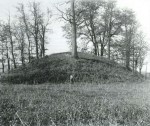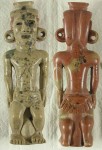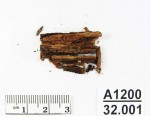The burial mound of the Adena culture on west side of the Scioto River in Chillicothe, Ohio, has been radiocarbon dated to the first century A.D. The Adena culture extended from around 800 B.C. to 200 A.D., a time known as the Early Woodland period, and until now, that thousand-year range was as specific as archaeologists could get in dating the Adena Mound. There were multiple ancient American mounds in the area, but this particular mound is the type site, the find considered the most representative of the culture. In this case, it’s also the source of the name of the ancient peoples because the mound was located on the estate of Ohio Governor Thomas Worthington, an estate he named Adena, the Hebrew word for “delightful place.” Thus the pinpointing of its age sheds a whole new light on the early history of Ohio and the United States.
 There is nothing left of Adena Mound today. Almost 27 feet high, 140 feet in diameter with a circumference of 445 feet as measured in 1901, the once dominant mound is now a slight bump in the road in a Chillicothe subdivision. In the 1840s, archaeologists excavated the Mound City tumuli north of Adena Mound and Chillicothe group of mounds south of it. They tried to do the same to Adena Mound, but the Worthington family (the governor himself died in 1827) refused to allow any digging. It wasn’t until the property was sold to Joseph Froehlich in the waning days of the 19th century that the virgin mound, topped with mature trees, was cleared and excavated.
There is nothing left of Adena Mound today. Almost 27 feet high, 140 feet in diameter with a circumference of 445 feet as measured in 1901, the once dominant mound is now a slight bump in the road in a Chillicothe subdivision. In the 1840s, archaeologists excavated the Mound City tumuli north of Adena Mound and Chillicothe group of mounds south of it. They tried to do the same to Adena Mound, but the Worthington family (the governor himself died in 1827) refused to allow any digging. It wasn’t until the property was sold to Joseph Froehlich in the waning days of the 19th century that the virgin mound, topped with mature trees, was cleared and excavated.
It was William C. Mills, curator of archaeology of the Ohio Historical Society, who took on the job. According to his published account, he was saving the mound’s archaeological importance in the nick of time because Froehlich wanted to use the fertile alluvial valley soil for farming and so planned to destroy the mound. According to a letter Mills wrote to a colleague in February of 1901, however, he had approached Froehlich proposing a dig as soon as the property left Worthington hands so he wasn’t so much a savior as an opportunist at best, instigator at worst.
 In June of 1901, Mills signed a contract with Froehlich to excavate the mound and dump the compacted earth from which it was built in a nearby cut of the Baltimore & Ohio Railroad. Froehlich cleared all the trees from the surface first, then Mills’ team started at the top and dug down in five foot sections. He found three strata, layers of construction and use. The first and earliest layer was made of dark sand from neighboring Lake Ellensmere. It was packed together so hard diggers had to use pickaxes to budge it. The second layer was lighter sand mixed with soil. The third was leaf mould, most likely a natural accumulation from when the mound was covered with trees.
In June of 1901, Mills signed a contract with Froehlich to excavate the mound and dump the compacted earth from which it was built in a nearby cut of the Baltimore & Ohio Railroad. Froehlich cleared all the trees from the surface first, then Mills’ team started at the top and dug down in five foot sections. He found three strata, layers of construction and use. The first and earliest layer was made of dark sand from neighboring Lake Ellensmere. It was packed together so hard diggers had to use pickaxes to budge it. The second layer was lighter sand mixed with soil. The third was leaf mould, most likely a natural accumulation from when the mound was covered with trees.
Mills found human remains in both construction layers. The earliest stratum had 23 burials, the second 13. The burial practices differed significantly between the two stages. The first round of burials were concentrated at the base of the mound and were considerably more elaborate. The deceased were wrapped in bark and/or textiles and buried in crypts made of logs. The second period burials were spread out and had no log crypts. The grave goods were also far more dense in the first period. Twenty of the 23 burials included funerary objects while only four of the 13 second period burials included funerary offerings.
 One particular burial stood out. Burial 21, found at the north base of the mound, was an adult male buried in a large sepulcher made of logs up to 17 inches in diameter. The floor was made of bark and the roof of smaller logs and brush. Grave goods buried with this man included 500 shell beads, once sewn to a loincloth, three strings of bone beads and freshwater pearls, a raccoon effigy carved out of a shell, seven flint spear points, three flint knives and three antler spear points. It was what he held in his left hand that made Mills’ heart sing: it was a pipe carved into the effigy of a man, deity or anthropomorphic figure of some kind.
One particular burial stood out. Burial 21, found at the north base of the mound, was an adult male buried in a large sepulcher made of logs up to 17 inches in diameter. The floor was made of bark and the roof of smaller logs and brush. Grave goods buried with this man included 500 shell beads, once sewn to a loincloth, three strings of bone beads and freshwater pearls, a raccoon effigy carved out of a shell, seven flint spear points, three flint knives and three antler spear points. It was what he held in his left hand that made Mills’ heart sing: it was a pipe carved into the effigy of a man, deity or anthropomorphic figure of some kind.
The Adena Effigy Pipe, as it became known, is the first representation of a human in Ohio history. Carved out of pipestone, a form of catlinite native to the hills along the Scioto River which is soft when first quarried but hardens when exposed to air and heat, the Adena Pipe is one of a kind. Plenty of Adena pipes have been found, but they’re relatively simple  tubular pieces with a widened bottom for the bowl and a hole at the top for a mouthpiece. This is the only Adena pipe ever discovered to be carved in the shape of a person. It is eight inches tall and weighs a pound, significant heft for a pipe. The figure wears large ear spools in his pierced ears (round jewelry had been found in burial mounds before, but the Adena Effigy Pipe provided the explanation for their use) and an unusual loincloth decorated with carved lines in the front that may be stylized animal figures and a feather bustle in the back.
tubular pieces with a widened bottom for the bowl and a hole at the top for a mouthpiece. This is the only Adena pipe ever discovered to be carved in the shape of a person. It is eight inches tall and weighs a pound, significant heft for a pipe. The figure wears large ear spools in his pierced ears (round jewelry had been found in burial mounds before, but the Adena Effigy Pipe provided the explanation for their use) and an unusual loincloth decorated with carved lines in the front that may be stylized animal figures and a feather bustle in the back.
Last May the Adena Pipe was named the official state artifact of Ohio thanks to the indefatigable lobbying efforts of four years of Fourth-graders at the Columbus School for Girls. Still, its precise date remained as much a mystery as the dates for the rest of the mound. Along with former Ohio State University provost Richard Sisson, the Columbus School for Girls helped raise the funds to finance the new C-14 dating.
 It was Mills’ foresight that made the new dating possible. Despite the horrifying destructiveness and hastiness of the dig — the mound was busted down to nothing by the end of 1901 — and the vague disposition of the human remains, at least one set of which appears to have been shipped to the Smithsonian while the rest are lost, Mills made a point of keeping several pieces of black locust tree bark used to line the central burial in the mound and fragments of coarsely woven cloth found within. There was nothing he could do with them at the time. They weren’t pretty, so no institution would be interested in displaying or studying them. There was no radiocarbon dating in 1901. Even after there was nearly 50 years later (Willard Libby led the team that discovered carbon-14 dating in 1949), for decades the sample size required to date organic materials was so large the Adena Mound specimens could not be tested.
It was Mills’ foresight that made the new dating possible. Despite the horrifying destructiveness and hastiness of the dig — the mound was busted down to nothing by the end of 1901 — and the vague disposition of the human remains, at least one set of which appears to have been shipped to the Smithsonian while the rest are lost, Mills made a point of keeping several pieces of black locust tree bark used to line the central burial in the mound and fragments of coarsely woven cloth found within. There was nothing he could do with them at the time. They weren’t pretty, so no institution would be interested in displaying or studying them. There was no radiocarbon dating in 1901. Even after there was nearly 50 years later (Willard Libby led the team that discovered carbon-14 dating in 1949), for decades the sample size required to date organic materials was so large the Adena Mound specimens could not be tested.
 Advances in technology now make it possible to obtain dates from much smaller samples. Using two pieces of bark and a piece of the textile, researchers were able to obtain three dates. The bark samples both dated to around 40 A.D. The cloth is older, dating to 140 B.C. Archaeologists believe it was an heirloom textile used to enshroud the dead.
Advances in technology now make it possible to obtain dates from much smaller samples. Using two pieces of bark and a piece of the textile, researchers were able to obtain three dates. The bark samples both dated to around 40 A.D. The cloth is older, dating to 140 B.C. Archaeologists believe it was an heirloom textile used to enshroud the dead.
Bradley T. Lepper, Mills’ heir as curator of archaeology for the Ohio Historical Society and co-author of the dating study, explains its significance:
If we are to understand the historical processes that led to the rise of the Hopewell culture from its roots in the preceding Adena culture, we first have to be able to place key events into a reliable chronological framework.
The Adena Mound, as the type site of the Adena culture, is an important cultural landmark in Ohio’s past. Knowing its relationship, in time as well as space, to the other earthworks in the Scioto Valley will help archaeologists eventually write the history of this important chapter of our past.